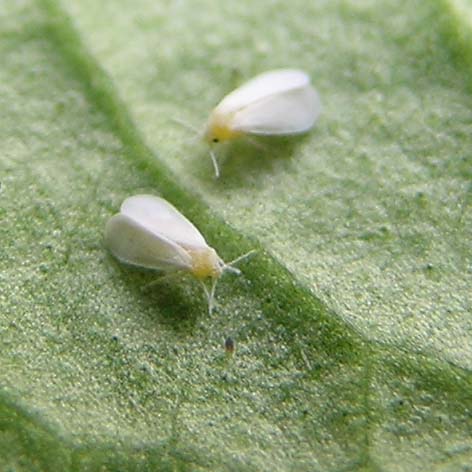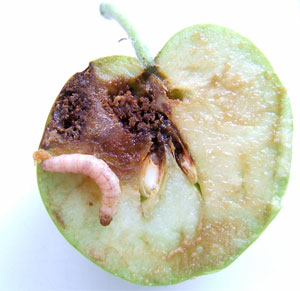Seasonal Pests
Warming weather brings out a number of insect pests which include; grass grub beetles, codlin moth, whitefly, leaf hoppers, spider mites, aphids and many more.

Whitefly
The later 4 when left without control, will quickly build up their populations making for a real problem later in summer.
The first two will be worse next season if allowed to breed and in the meantime they will do lots of damage to plants and fruit.
Codlin moth attack apples, pears and walnuts ruining the fruit they are able to infest.
My suggested controls are; hang a small container of treacle in the lower branches of each tree using an onion bag. This attracts the male moths and by monitoring the trap you can determine when the pests are on the wing. Within a few days of finding an influx of moths in the treacle spray the young apples (or other affected fruit) with Neem Tree Oil for total coverage. Repeat this every 7 days till activity in the trap stops.

Codling Moth Caterpillar
Grass grub beetles are on the wing early in the evening and they will eat the foliage of roses, citrus and a number of other plants. Each female beetle is capable of laying 300 eggs during the few weeks they are active which means lots of grubs to ruin your lawns.
In my first book, Wally’s Down to Earth Gardening Guide, I gave this excellent control to kill the beetles; You can set up a grass grub beetle trap by placing a trough, such as the one used when wall-papering, directly underneath a window near a grassed area. Fill the trough with water to about two-thirds of its capacity, then place a film of kerosene on top of the water. Put a bright light in the window, the beetles fly towards the lit window, hit the glass and fall into the trough. The kerosene acts as a trap, preventing the fallen beetles from climbing out. (this is done in the early part of the evening prior to dusk and left in operation till activity stops). You can extend this method to areas away from the house by using a glass tank, such as might be used for an aquarium. Place the empty tank into a tray containing several inches of water (and the kerosene), and position a light inside the glass tank. By adding a sheet of ply or something similar over the top of the tank, you will ensure that the light shines only through the sides of the tank above the waiting water and kerosene. It is better to use a dome-shaped battery-powered light rather than an ordinary torch for this job as the bigger light makes the trap more effective.
If the tray and tank are raised off the ground and placed on something like a table, you will get an even better result. Another solution when you find the foliage of plants such as citrus or roses is being eaten, in the early part of the evening, is to go out with a torch and check the plants for beetles. If you find a number of them then spray the beetles with either Professor Macs 3 in 1 for lawns or with Key Pyrethrum.
Leaf hoppers will damage a number of garden plants and if not controlled early they will be a real menace later in the season. Often you can have an ongoing problem if you do not check all the plants in your garden to find out where the pests are. For instance you can spray and control the leaf hoppers on your passion fruit vine only to find that they have re-infested the plant a few days later. They maybe breeding on other vines or ferns and becoming a menace, spray all areas where found with Neem Tree Oil and repeat a couple of times or till controlled, every 7 days. Whitefly can infest tomato plants, cucumbers, citrus and a number of other plants. A number of sprays, several days apart, with a combination of Neem Tree Oil and Key Pyrethrum, these should be applied just before dusk when they have settled for the night. Spray under and over the leaves of effected plants. Neem Tree Granules sprinkled on the soil in the root zone of tomatoes will keep the pests under control. These should be placed there at planting time and repeated about every 6 weeks.
The same method applies to cabbages and other brassicas for white butterfly caterpillars.
- Aphids can be sprayed with a combination of Neem Tree Oil and Key Pyrethrum or alternatively with soapy water made from cake sunlight soap.
- Spider mites are another pest that quickly build up populations and can be noticed by the small fine webs they make on plants. A spray with Liquid Sulphur will stop them in their tracks.
- Scale insects can be controlled with sprays of Neem Tree Oil, spray for total coverage of the plant affected.
- Mealy bugs not only are found in the foliage of plants but also in the root system. Spray the foliage with Neem Tree Oil and sprinkle Neem Tree Granules under the the plant in the root zone. These can also be sprayed with the oil to increase their effectiveness.
- Citrus tree borer and borer in other plants can be controlled be controlled by sprinkling Neem Tree Granules in the root zone and then with a solution of Neem Tree Oil made at 25mils per litre of warm water, watered across the granules. Repeat the oil application a month later. Thrips in rhododendrons can be controlled by using the same method.
In fact the application of Neem Tree Oil and Granules often works well in many plants for insect control without the need to spray. This is a great advantage as larger plants with denser foliage are very difficult to spray.
The real secret of insect pest control is to get started early in the season before their populations start to build up. This means checking your plants every week for any sign of problems and taking action.
You may see a couple of whitefly adults flying when you disturb a plant and think there is not a problem, but a week or so later there will be a lot more and the populations will build quickly from that point and become a major problem as summer progresses. The other aspect is to control all the places where the pests are breeding otherwise they will only keep on re-infesting the plants you are spraying or treating.
When a large population of pests have built up on a neighbouring property you have an on going problem unless they are controlled at source. Get permission from the neighbours to treat the problem on their property, if you don’t you will fight all summer in your own garden and even start to believe the control methods are not working.
Start early and check all breeding areas.
Happy gardening!
Wally Richards


A low cost, green eco friendly, healthy natural way to deal with aphids is to make a homemade liquid from soapberry which grows on the Chinaberry tree and has been used for thousands of years. It works very effectively.
Do you know of an organic way to get rid of Snails besides burying half full beer cans.
Hi Sandy,
You can use coffee grounds from your local espresso bar – (ask for a big bag at the end of the day) – then sprinkle the grounds about 1 cm tall and 3 cm deep around your plants.
You cal also go out with a torch at night and collect them.
Regards
Tim D